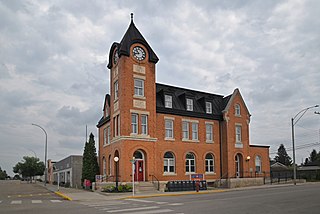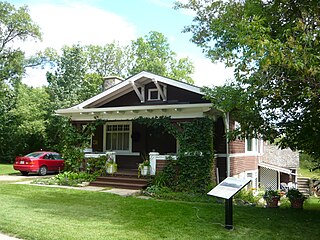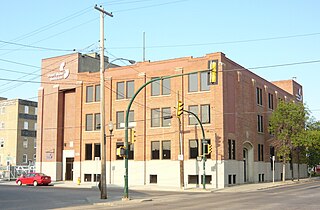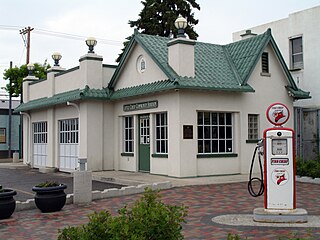
Battleford is a town located across the North Saskatchewan River from the city of North Battleford, in Saskatchewan, Canada.
Quill Lake is a village in the Canadian province of Saskatchewan within the Rural Municipality of Lakeside No. 338 and Census Division No. 10. It is 170 km east of Saskatoon and 200 km northeast of Regina.

The Rural Municipality of Corman Park No. 344 is a rural municipality (RM) in the Canadian province of Saskatchewan within Census Division No. 11 and SARM Division No. 5. Located in the central portion of the province, the RM surrounds the City of Saskatoon.

Furdale is an unincorporated community adjacent to the southern city limits of Saskatoon, Saskatchewan, west of Highway 219 and on the east bank of the South Saskatchewan River. The hamlet's name comes from the many fur farms located in the area beginning around the 1930s.
Floral, Saskatchewan is an unincorporated community in the province of Saskatchewan, Canada.

Nutana is a primarily residential neighbourhood located near the centre of Saskatoon, Saskatchewan, Canada. It includes the business district of Broadway Avenue. It comprises a nearly even mixture of low-density, single detached dwellings and apartment-style multiple unit dwellings. As of 2009, the area is home to 6,261 residents. The neighbourhood is considered a middle to upper-income area, with an average family income of $67,657, an average dwelling value of $206,830 and a home ownership rate of 51.3%. First established in 1883, Nutana was the original settlement of what now makes up the city of Saskatoon.

Eastview is a mostly residential neighbourhood located in south-central Saskatoon, Saskatchewan, Canada. It is a suburban subdivision, consisting of low-density, single detached dwellings, low-rise apartment buildings and semi-detached houses. As of 2007, the area is home to 3,566 residents. The neighbourhood is considered a middle-income area, with an average family income of $58,703, an average dwelling value of $260,050 and a home ownership rate of 51.6%.

Dundurn is a town of only 647 residents surrounded by the RM of Dundurn No. 314, in the Canadian province of Saskatchewan. Dundurn is located on Highway 11, or Louis Riel Trail, in central Saskatchewan, about 42 km south of Saskatoon. As well as being an agricultural town, it is a bedroom community for both Saskatoon and Canadian Forces Detachment Dundurn, which is located 6 kilometres (4 mi) north of town and is a detachment of 17 Wing Winnipeg.

The Forestry Farm Park and Zoo is a forested park and zoo located in Saskatoon, Saskatchewan, Canada. The park was originally established as the Dominion Forest Nursery Station and later Sutherland Forest Nursery Station. Between 1913 and 1966 was responsible for growing and shipping 147 million trees shipped across the northern prairie provinces. The first shipment of trees were sent to farmers in 1916. The park is designated a National Historic Site of Canada. The nursery grew caragana, ash, maple, elm, and willow. After the nursery closed in 1966 a portion was re-opened as a city park.
Storey and Van Egmond was an architectural partnership in Regina, Saskatchewan, Canada, that functioned from 1907 to 1924. Initially, the principals were Edgar M. Storey (1863-1913) and William Gysbert Van Egmond (1883-1949).

The Odd Fellows Temple Building is a landmark building located in downtown Saskatoon, Saskatchewan, Canada. Built by the Independent Order of Odd Fellows the building served as a meeting place, ball room and temple until being sold in 1959 to the Saskatoon Labour Council. The building was officially designated a heritage property on April 19, 1983.

The Hutchinson Building is a landmark building located in downtown Saskatoon, Saskatchewan, Canada. The building was designed by architect Frank P. Martin built to house the Saskatoon Hardware Store Ltd until 1970 then the building was taken over by Saskatoon Handicraft Supplies until 1995. The building was designated a heritage property on August 9, 1999.

The Bowerman House is a designated Municipal Heritage Property located in the Holiday Park, neighborhood of Saskatoon, Saskatchewan, Canada. The home is of a crafts-man "Western Stick" style. The house was built as a hunting lodge by Allan Bowerman, graduate from Kingston Military College, first postmaster in Saskatoon on the west side of the river, and member of Saskatoon's first town council. Bowerman was also responsible for the development of the Canada Building. The home was designed by Walter William LaChance. Bowerman sold the home in 1917 after the end of a construction boom in the city.
The Saskatoon Electrical System Substation is a municipal designated historic building located in the Nutana neighborhood of Saskatoon, Saskatchewan, Canada. The property contains a two-story building in a Modern Classical style, made of No. 2 Redcliff, Light Claybank and Tee Pee Mocha brick construction. The building was constructed in 1929 by Saskatoon Light & Power along with two other such stations to meet the growing electrical demand of the city; declared a heritage site on December 4, 2000; and renovated into offices in the 1990s the building now houses the offices of the architectural firm of Kindrachuk Agrey Architects.

The Sommerville/Petitt House is a municipally-designated, historic building located in the Nutana neighbourhood of Saskatoon, Saskatchewan, Canada. The property is a 2+1⁄2-story, stucco-and-brick house in a blended Tudor Revival and Spanish Revival style constructed in 1912. Features of the building include a tower topped with a bell-cast dome, a large arched porch with porte-cochere, and a carriage entrance supported by fieldstone pillars.

The Arthur Cook Building is a designated historic building in the Central Business District, of Saskatoon, Saskatchewan, Canada. The three-storey brick and concrete warehouse was built in 1928 by the Saskatoon Cartage and Warehouse Company. It was designed by Saskatoon architect David Webster and built by the A.W. Cassidy Co. Ltd. It was sold to MacCosham Storage and Distribution in 1945 who used it until 1978. In 1978 the building was purchased by the City of Saskatoon and became the city's central stores, as well as housing the archives.
The Landa Residence is a designated Municipal Heritage Property located in the Riversdale, neighborhood of Saskatoon, Saskatchewan, Canada. Thomas E. Heath, Saskatoon's Early Fire Chief lived in the home from 1913–1915. In 1921, the house became the family residence of William and Fanny Landa, the first Jewish family to settle in Saskatoon. William Landa was a carriage maker who immigrated from Russia established the Landa Carriage Works that eventually become the Landa Auto Body Works. The building is of a Pre-World War I Prairie Vernacular architectural style.

The F. P. Martin House is a designated Municipal Heritage Property located in the Nutana, neighborhood of Saskatoon, Saskatchewan, Canada. The house was built by local architect Frank Percy Martin, in a unique Cottage Style with double dormers, Gothic doorways, and lattice windows.

The Albert Community Centre is a designated Municipal Heritage Property located in the Varsity View, neighborhood of Saskatoon, Saskatchewan, Canada. Originally built as the Albert School, the 2+1⁄2-storey brick building served as a public school until 1978 when the building was sold to the city and became the Albert Community Centre. The school was originally named for Prince Albert, Queen Victoria's Consort. The most noticeable feature of the building include limestone trim, crenellated tower, crossed mullioned windows, dormers and curved parapet gables.

The Little Chief Service Station is a designated Municipal Heritage Property located in the Riversdale, neighborhood of Saskatoon, Saskatchewan, Canada. It was originally built as a gas service station for Texaco Oil Company of Canada. Cars and farm vehicles were often serviced at the station while owners shopped in the Riversdale area. The restored building design makes use of white stucco walls, rounded roof tiles, decorative brick, heavy tiled cornices, roof parapets, iron windows and copper gutters.
















